Why concrete grease traps fail
- Sep 13, 2016
First in a three-part series. Read part 2, Why Fiberglass Grease Traps Fail, and part 3, Why Steel Grease Traps Fail.
Grease interceptors – at least most grease interceptors – don’t last forever. Understanding why some fail might help keep your current interceptor running efficiently. If you’re in the market for a new grease interceptor, understanding why they fail might help you make a smarter choice.
 Grease trap failure means one of two things:
Grease trap failure means one of two things:
- The grease trap stops functioning properly because it’s been damaged in some way.
- The grease trap stops functioning properly because it’s become less efficient or been pushed beyond its performance limits.
Grease interceptors have different weaknesses and points of failure depending on what they’re made of. Those materials affect how durable a particular grease trap is, and often affect how it’s designed. Design choices, in turn, also affect the reliability and durability of a grease trap.
Today we take a look at why concrete grease traps fail.
Why concrete grease traps fail
Concrete grease traps are the oldest type of grease interceptor still in common use, but they have a number of inherent problems that lead to failure.
Efficiency. Concrete traps are only efficient until they are about 25% full, and then they dramatically lose efficiency. That means grease is no longer retained in the trap but instead passes through into the sewers (which can lead to fines, among other problems). This is why concrete tanks must be pumped out long before they are full, and why they must be made much larger than the volume of grease they’re designed to hold.
Corrosion. Concrete is subject to corrosion from the acids that develop in grease traps. Grease and solids also tend to build up in the corners, which are harder to reach and properly clean, providing more opportunities for the bacteria that produce hydrosulfuric acid to thrive, accelerating corrosion.
Piping materials. Inlet and outlet piping in concrete grease traps is usually made of steel. It’s subject to corrosion, just like the concrete interceptor itself, and may also be damaged during cleaning. Damaged pipes lead to leaks and other problems.
Concrete traps last, on average, 10-30 years, depending on the quality of the concrete and how easily damage can be patched instead of replacing the whole interceptor.
Installing a concrete grease trap is a big deal: a large hole must be dug and concrete excavated. It requires heavy equipment, several workers and is likely to disrupt any existing business operations. If you’ve got a concrete grease trap, chances are you’ll be replacing it in a few years.
Durability is just one aspect of choosing a grease trap. If you want more detailed information on choosing a grease trap, please download our free guide, “How to Choose a Grease Interceptor.”






